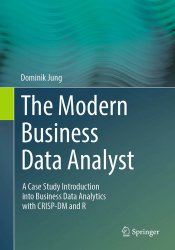The Modern Business Data Analyst: A Case Study Introduction into Business Data Analytics with CRISP-DM and R
- Добавил: literator
- Дата: 6-07-2024, 12:32
- Комментариев: 0
 Название: The Modern Business Data Analyst: A Case Study Introduction into Business Data Analytics with CRISP-DM and R
Название: The Modern Business Data Analyst: A Case Study Introduction into Business Data Analytics with CRISP-DM and RАвтор: Dominik Jung
Издательство: Springer
Год: 2024
Страниц: 312
Язык: английский
Формат: pdf (true)
Размер: 13.6 MB
This book illustrates and explains the key concepts of business data analytics from scratch, tackling the day-to-day challenges of a business data analyst. It provides you with all the professional tools you need to predict online shop sales, to conduct A/B tests on marketing campaigns, to generate automated reports with PowerPoint, to extract datasets from Wikipedia, and to create interactive analytics Web apps. Alongside these practical projects, this book provides hands-on coding exercises, case studies, the essential programming tools and the CRISP-DM framework which you'll need to kickstart your career in business data analytics.
The different chapters prioritize practical understanding over mathematical theory, using realistic business data and challenges of the Junglivet Whisky Company to intuitively grasp key concepts and ideas. Designed for beginners and intermediates, this book guides you from business data analytics fundamentals to advanced techniques, covering a large number of different techniques and best-practices which you can immediately exploit in your daily work.
The book does not assume that you have an academic degree or any experience with business data analytics or Data Science. All you need is an open mind, willingness to puzzle and think mathematically, and the willingness to write some R code. This book is your all-in-one resource to become proficient in business data analytics with R, equipped with practical skills for the real world.
Hence, this book is particularly about the intersection of business data analytics and Data Science to taggle the following questions:
• How to plan and setup a business data analytics project
• How to work with R as a programming language to conduct your project
• How to understand and work with your business data
• How to use analytics models to predict and understand your business
• How to build tools that a manager can use to make well-informed decisions, based on facts and not on feelings
You probably ask yourself, why should I learn R to make business data analytics? Why can I not use Microsoft Excel, Python or C++? The answer is: I would not call R my favorite programming language. There are other languages like Python that I find better designed and more beginner friendly. I also teach other programming languages like Python at university and see many benefits in it. But R on the other hand was built by statisticians as environment for statistics and business data analytics, which makes it the perfect tool to wrangle and dive deep into business data. And will help you to generate and deploy your analytics models easily.
In the R community many free and useful packages exist to boost your business data analytics pipelines: For instance, making good-looking visualizations that have publication-quality is a difficult undertaking in most analytics tools like Python or Matlab. And I can tell you that R and its ggplot2 package is probably the most advanced tool and best solution to make professional visualizations to support your analysis and communicate your results. From my time at university, I know that even if you started in another language like Python and plan now to publish your results or want to design posters or infographics for big journals and newspapers you will end up using R for this specific task.
Dashboards with Shiny, or reports with RMarkdown are state-of-the-art solutions for your business data analytics workflow. The most relevant basics can be learned in 1-2 hours of work and you can produce first results for yourself in little time. R allows you to communicate your models and findings in an interactive webapp easily without changing or migrating to another analytics tool.
Every time I want to quickly dive deep into data and understand and model something statistical, I end up using R. With R you can produce higher quality outcomes with less effort compared to other programming languages like Java, Skala and in particular Python, if you want to make business data analytics. And that is what we plan to do. R is the tool that is designed to do business data analytics and statistics. And hence, that makes it my first choice to make business data analytics.
Скачать The Modern Business Data Analyst: A Case Study Introduction into Business Data Analytics with CRISP-DM and R
Внимание
Уважаемый посетитель, Вы зашли на сайт как незарегистрированный пользователь.
Мы рекомендуем Вам зарегистрироваться либо войти на сайт под своим именем.
Уважаемый посетитель, Вы зашли на сайт как незарегистрированный пользователь.
Мы рекомендуем Вам зарегистрироваться либо войти на сайт под своим именем.
Информация
Посетители, находящиеся в группе Гости, не могут оставлять комментарии к данной публикации.
Посетители, находящиеся в группе Гости, не могут оставлять комментарии к данной публикации.
